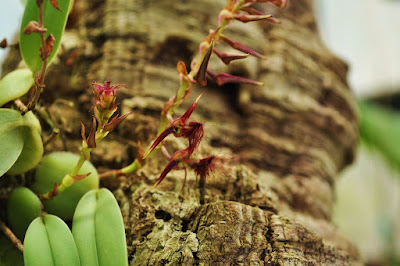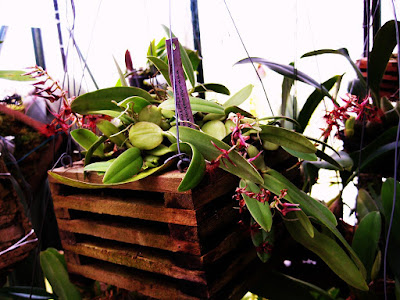Bulbophyllum barbigerum is native to the tropical forests of Liberia, Ivory Coast, Ghana, Nigeria, Gabon, Cameroon, Congo, Zaire, Central African Republic and Sierra Leone. It grows on mossy tree trunks and in crowns of trees in evergreen and deciduous forests up to elevations of 500-2500 meters...
Bulbophyllum barbigerum also called as The Bearded Bulbophyllum, Phyllorchis barbigera, is a species of the genus Bulbophyllum. This species was described by John Lindley in 1837.
IDENTIFY BULBOPHYLLUM BARBIGERUM
Bulbophyllum barbigerum is native to the tropical forests of Liberia, Ivory Coast, Ghana, Nigeria, Gabon, Cameroon, Congo, Zaire, Central African Republic and Sierra Leone. It grows on mossy tree trunks and in crowns of trees in evergreen and deciduous forests up to elevations of 500-2500 meters.
It is a small sized, warm to cold growing epiphyte with orbicular or ovoid, somewhat flattened, 1.5 - 4 cm long pseudobulbs carrying a single, apical, narrowly elliptic, emarginated leaf.
The Bearded Bulbophyllum blooms in the spring and early summer on a basal, 7.5 to 19 cm long, racemose, spreading or erect inflorescence with ovate bracts and carrying several to many flowers. The flowers are hairy and have an unpleasant odor.
BULBOPHYLLUM BARBIGERUM CARE AND CULTURE
Cultural information should only be used as a guide, and should be to be adapted to suit you. Your physical location; where you grow your plants, how much time you have to devote to their care, and many other factors, will need to be taken into account. Only then can you decide on the cultural methods that best suit you and your plants.
Light:
Bulbophyllum barbigerum needs a light level of 24000-30000 lux. The ideal photoperiod is 13 hours. It loves a lot of light but does not tolerate direct sun, which must be shielded.
Temperature:
This orchid grows best under warm / intermediate-hot conditions: 27-28 ° C during the day and 20-21 ° C at night. In winter, the ideal temperatures are 25 ° C during the day and 17-18 ° C at night.
Humidity:
The Bearded Bulbophyllum needs the humidity of 75-85%.
Substrate, growing media and repotting:
It is possible to grow Bulbophyllum barbigerum both in pots and in bare roots (which would be the perfect environment for this species). If you choose the vase, the best substrate would be the medium-sized bark (1.5-3 cm), or the coconut fiber. It does not require frequent repotting, so repot only when the orchid becomes too large for its vase, or when the substrate has aged (which happens every 2-3 years).
Watering:
During the growing season (March to October) this orchid is frequently get water, as soon as the substratum has dried well enough (but before it becomes completely dry). In winter the watering slow down and for the most part they are replaced by light daily spraying of the upper part of the substrate. In this period it gets water once every 10-12 days. The bare root specimens get water every day (in the warmer periods 2-3 times a day).
Fertilizer:
It is advisable to use 1/4 (1/8 for bare root plants) of the dose indicated on the bottle of a special liquid fertilizer for orchids, once every 4 wetting (but no more often than once every 10 days). Before fertilizing the plant it is necessary to water it to avoid the harmful contact of the fertilizer with the dry roots.
Rest period:
In cultivation Bulbophyllum barbigerum needs a period of light rest, with less frequent watering but never completely absent: the substrate must never remain completely dry for more than 3 days. I would advise to lightly vaporize the surface of the substrate daily, and to water once every 10-12 days, keeping the air humidity high. Temperatures during this period should be 25 ° C during the day and 17-18 at night. If the leaves and pseudobulbs begin to shrivel, the watering should increase a little.















COMMENTS